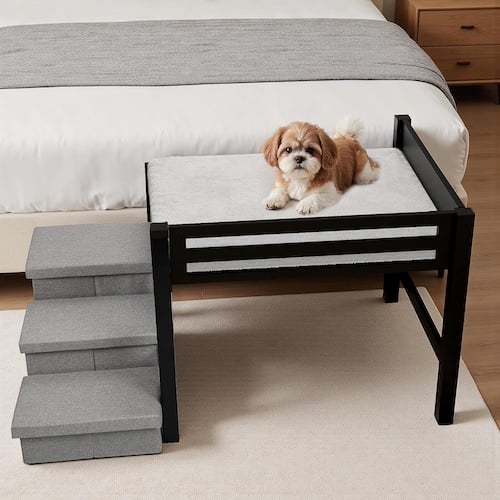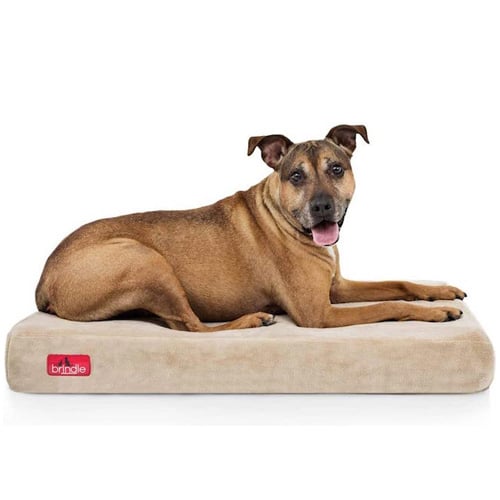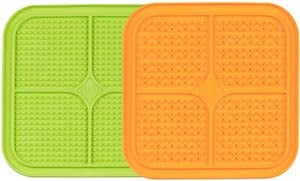 If you have a dog, chances are you've had at least one moment of wondering whether your dog should be sleeping in bed with you. Especially if it's the middle of the night and you find yourself dangling off the side of the mattress while your dog sprawls comfortably. And while it might be tempting in those moments to banish your dog from the bed altogether, don't get carried away too soon.
If you have a dog, chances are you've had at least one moment of wondering whether your dog should be sleeping in bed with you. Especially if it's the middle of the night and you find yourself dangling off the side of the mattress while your dog sprawls comfortably. And while it might be tempting in those moments to banish your dog from the bed altogether, don't get carried away too soon.
As a dog trainer, I get asked this question a lot. And it really comes down to what you want and whether there are any issues that might make it unhealthy or unsafe.
I personally sleep in my bed with both of my dogs (although my older dog tends to prefer her own bed on the floor most of the time). And I have friends who have their dogs sleep in crates in a separate room altogether.
There's no single "right" answer to whether your dog is allowed to sleep in your bed, has their own bed on the floor, or sleeps outside the bedroom. It depends on your health, sleep quality, your dog's behavior, and what helps everyone get the best rest.
Let's look at the most common concerns and benefits of co-sleeping with your dog, and how to decide what's right for you.
Things to Consider If You Want Your Dog to Sleep in Bed With You
Health & Hygiene
Dogs bring a bit of the outdoors in with them, from dirt and dander to pollen, and parasites like fleas and ticks. For most healthy adults, sharing the bed with a dog doesn't pose a significant health risk. But there are certain situations where you might want to consider having separate sleeping arrangements:
- Allergies and Asthma: Dander and pollen trapped in fur can aggravate symptoms. Keeping the bedroom as a pet-free zone, regularly bathing and grooming your dog, or using a True HEPA air purifier can help.
- Parasites and Bacteria: Flea and tick preventatives are essential year-round, whether your dog sleeps in bed with you or not. But this is especially important if you share the bed. Have your veterinarian regularly check for internal parasites.
Learn more about what flea and tick control options would be best for your dog.
Wipe your dog's paws after being outside, and use grooming wipes to clean their tush after going to the bathroom or before heading to bed. Make sure to wash bedding frequently as well, to remove any bacteria that might have caught a ride on their paws and fur or from their saliva. - Immunocompromised individuals: People with weakened immune systems may be at higher risk for infections from seemingly innocent contact with dogs, such as bacteria from saliva, accidental contact from feces that might be on fur or paws, or scratches from long nails. Keep your dog's nails trimmed to help prevent accidental scratches.
It's best to have your dog sleep in their own bed if they are sick or dealing with skin issues or itchiness, at least until they are treated. If you or a family member have health concerns, talk to your healthcare provider about whether sleeping with your dog in the bed is a good idea.

Resource Guarding of the Bed
There's an old myth that allowing your dog on the bed can make them "dominant" or means they are "spoiled." That's simply not true. Allowing your dog to sleep on the bed doesn't cause aggression or resource guarding on its own. But it can reveal those issues if they're already present. If your dog growls when you move them, or guards a spot on the bed, it's not about being the "alpha." It's a sign of discomfort and insecurity that can be addressed with management and training.
If your dog is exhibiting resource guarding around the bed, I recommend not allowing them to sleep on the bed until you have addressed the issue. Give them a comfy sleeping spot close by and teach them how to get on and off furniture calmly.
If you have more than one dog and have noticed that there is tension around spaces, then I also recommend not allowing them to sleep on the bed with you. The last thing you want is to wake up underneath a dog fight because one decided they didn't like the other encroaching on their space.
To learn more about how to stop your dog's resource guarding of the bed, check out Resource Guarding in Dogs: What to Do (and NOT Do)
Safety for Small Dogs
For very small dogs, puppies, or senior dogs with mobility issues, sleeping in your bed can be risky. They can fall, get trapped in bedding, or rolled over by someone sleeping. If you move a lot during sleep, you might consider having your tiny dog sleep in a bed next to yours, or, if there's space, have their dog bed on top of your bed so they have a designated spot away from flailing limbs.
If you have a small dog or dog with mobility issues, make sure they're using a ramp or pet stairs to get on and off the bed (especially important for dogs with long backs, like Dachshunds and Corgis).

Potty Habits
If your puppy is still working on house training, it's best to wait until they can reliably hold it overnight. You don't want a potty accident in your bed, as it's very difficult to remove urine stains and scent from a mattress.
Even after your dog is potty trained, I recommend using a waterproof mattress protector under your regular sheets to protect from accidents — especially if you have an older dog struggling with incontinence issues.
Space & Partner Preferences
Even the biggest dog lovers have to admit that space can become an issue. Your dog might sprawl, burrow, or want to settle right up against you, which can make sleeping uncomfortable or too hot. This can be more of an issue if you share your bed with a partner, and it's worth having a conversation about boundaries and shared sleep space.
In multi-human homes, not everyone may feel the same about having a dog in the bed. Respecting each person's comfort level is important, and compromise can go a long way. To increase sleeping space without upsizing your entire mattress, consider a raised dog bed with stairs or a ramp to place alongside your bed. This way, your dog can still be close, but isn't taking up all your space.
The Co-Sleeper Hack: A Happy Middle Ground
 This approach is a great way to keep puppies or dogs close, but who aren't quite ready for full bed privileges. You can still offer reassurance and closeness while keeping potty training on track, preventing any wandering at night, and creating a designated sleep space for your dog. It's also especially helpful for dogs who hate being in a crate or who are struggling with crate training at night.
This approach is a great way to keep puppies or dogs close, but who aren't quite ready for full bed privileges. You can still offer reassurance and closeness while keeping potty training on track, preventing any wandering at night, and creating a designated sleep space for your dog. It's also especially helpful for dogs who hate being in a crate or who are struggling with crate training at night.
Created by Kim Brophey, this hack is all about setup. Place your dog's bed to the side of yours and tether your dog to the bedpost. Ideally, have them on a low-profile and lightweight harness, like the Blue9 Balance Harness, while tethered.
They should only have enough leash length to be on their bed or grab a drink of water from a water bowl placed to the side. Make sure there are a couple of toys available if they need to entertain themselves while you're in your bed. If they become restless or start to whine or bark, reassure them by calmly reaching down to pet them.
Learn more about how to use the Co-Sleeper Hack by downloading the PDF overview here.
Should Dogs Sleep With Kids?
This is a common question, and the answer depends on the dog, child, and supervision. I remember being incredibly excited as a kid to finally get permission to let my small dog sleep in my bed. It made me feel safe. She didn't quite enjoy it as much as I did, and would often hop down after I fell asleep to curl up on her dog bed and escape my flailing legs. And then when we got a much larger dog when I was in high school, I loved having him share the bed, even though I would often be squished up against the wall.
For older kids and well-trained, calm dogs, sharing a bed can strengthen their bond and help both feel secure. However, for young children or new dogs, it's best to wait. Even the gentlest dog can react suddenly if startled or squeezed during deep sleep.
If your child wants to sleep near their dog, set up a dog bed next to their bed instead. As your child matures and your dog's behavior is predictable, co-sleeping in the same bed may be safe to try. Watch their other interactions when they are resting together in other contexts or times of day to get a better understanding of how they may sleep together overnight.
What About Closing the Bedroom Door?
Some people prefer keeping their bedroom a dog-free zone, and that's perfectly fine. I actually recommend that all infants and young children's rooms are also dog-free for safety reasons. But it's important to remember that dogs are social creatures, and they typically prefer to sleep near their people.
Sleeping apart doesn't cause separation anxiety in dogs. Being shut out when they are used to sleeping near you can cause a lot of stress and can trigger separation anxiety.
How to Stop Your Dog From Sleeping in Your Bed
If you want to have your dog sleep in their own bed or in a different area of the home, don't make the change suddenly. Make changes slowly.
Make sure they have a comfortable bed that matches their preferences. Some dogs prefer lots of blankets to burrow in, others want no blankets because it makes them too hot. Older dogs with arthritis or mobility can benefit from an orthopedic dog bed.
Move their bed farther away over time, pair it with good things (like a lick mat or special bedtime snack), and ensure they're comfortable before closing them out of the room entirely.
Installing a pet gate in your doorway can help with the transition until they are used to the closed door.
If you're only having them sleep on their own bed on the floor, rather than in a separate room, you may need to use an ex-pen to block off their access to the bed while you're sleeping, if they are big enough to jump up on their own.
If you have a puppy and know that you don't want to have them sleeping in your room, acclimate them to what will be their usual bed spot from the start. Learning how to sleep alone (or at least not up on the bed with you) is an important part of early-life training, as it helps prevent distress if your dog is ever boarded overnight, where they won't have their usual setup.
If your puppy is struggling with sleeping in their crate or designated spot alone, read my tips on Helping Your Puppy Sleep Through the Night.
Do What Works Best for You and Your Dog
Letting your dog sleep in your bed isn't a "bad habit," it's a personal choice. For some, it brings warmth and comfort, and for others, it disrupts sleep or triggers allergies.
Focus on what keeps everyone healthy, safe, and rested. With good hygiene, consistent training, and clear boundaries, you can decide what bedtime routine works best for your home.







